11 Facts About Ecuadorian Chicha (Saliva-Fermented Yuca Drink)
You’ve likely heard of chicha – the chew-and-spit alcoholic drink made in Ecuador’s amazon region. Here’s what you need to know about Ecuadorian chicha.
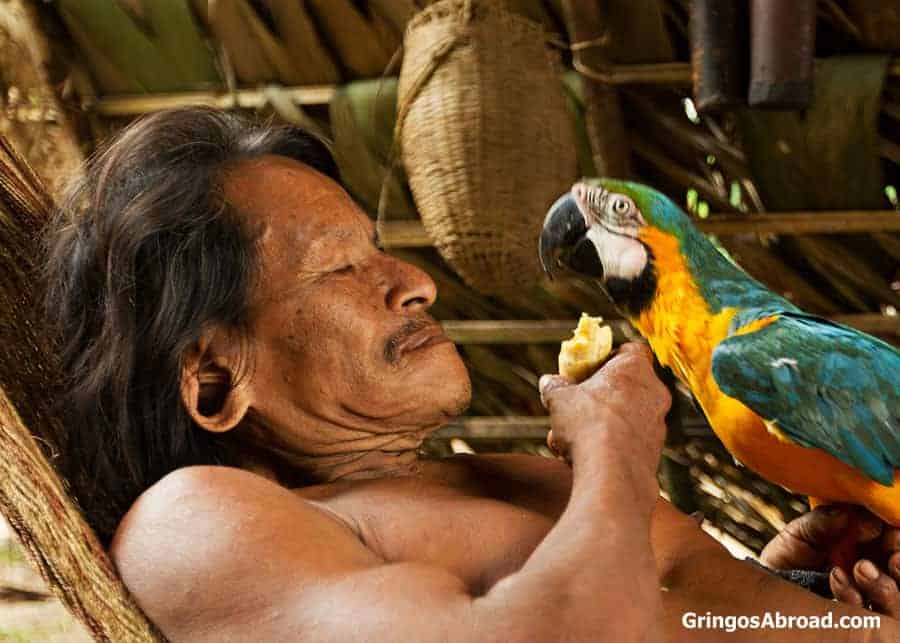
In this post, you’ll learn about Ecuadorian chicha – but first, here’s what’s involved in making it. Please remember to keep an open mind. This is an important tradition of a number of indigenous groups in Ecuador – and across Latin America.
Making Chicha in Ecuador’s Amazon
What Does Chicha Mean in Spanish?
In Latin America, chicha refers to a beverage, usually alcoholic. In Ecuador, Peru, and Brazil, traditional chicha is made with yuca. In Ecuador’s highlands, chicha is often made with corn or quinoa.
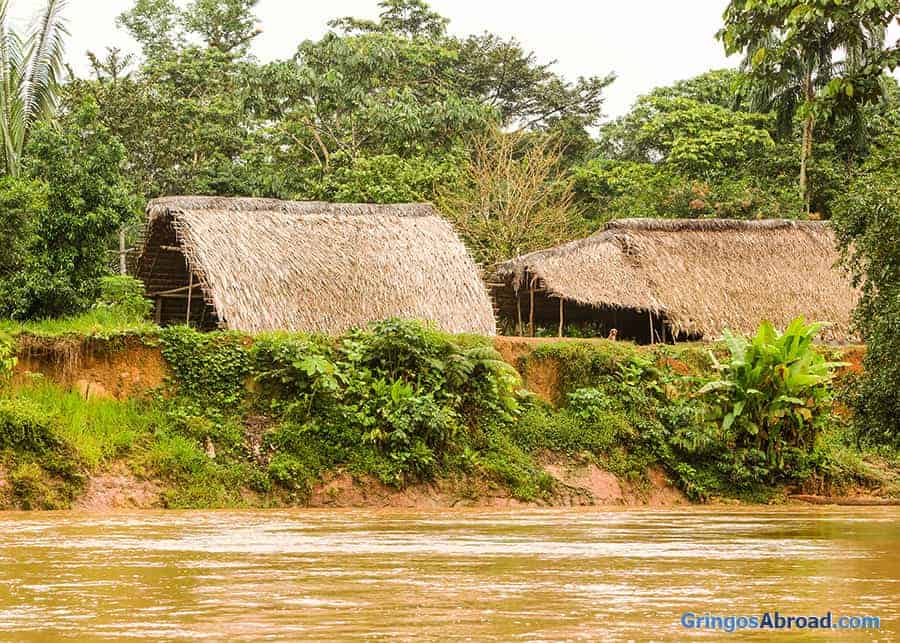
11 Things to Know About Ecuadorian Chicha
1. Yes, it’s really made by chewing and spitting
And then chewing and spitting some more.
2. It’s usually made with yuca…
Among travelers to Ecuador, the terms yuca and yucca are often used interchangeably. Some people say that one is Spanish and the other is English – but this isn’t correct.
What’s the difference between yuca, yucca and cassava?
- Yuca (aka cassava) is an annual crop that produces edible, starchy roots with a waxy finish. It’s official species name is manihot esculenta. This is what’s used in chicha.
- Yucca, on the other-hand, is an ornamental plant/tree in the agave family. The yucca flower is the state flower of New Mexico. The words (yuca / yucca) are not interchangeable.
3. … but you might also find it made with verde.
Verdes are green plantains (unripe) and are super starchy. When fully green, these are extremely hard and very difficult to peel.
4. First, the yuca (cassava) is washed, peeled and boiled.
Raw yuca is extremely hard. Before the chewing can begin, it is prepared and softened.
5. The saliva is actually part of the process.
The combination of starch and spit enzymes converts the starch to a simple sugar.
This simple sugar is then converted by bacteria (of which there is plenty, thanks to being in lots of mouths) or wild yeast into alcohol.
6. The yuca juice begins to ferment in just a few hours.
The saliva accelerates the fermentation process and within just a few hours, you’ll have a mild sweet and sour chicha.
7. After 1 to 7 days you’ll get an alcoholic drink.
The longer you wait, the stronger it’ll be.
8. Children drink new chicha.
Children are offered unfermented chicha (without alcohol) while the adults (including guests) drink the fermented batch. The highest alcohol content is reserved for men.
9. Chicha de yuca is popular throughout Ecuador, Peru and Brazil.
There are many versions of chicha, including corn, sweet potato, banana, and quinoa.
10. Varieties of chicha are popular across Latin America.
Not all chicha is like that in eastern Ecuador. Here are some of the varieties of Chicha you’ll find in Central and South America.
- Nicaragua: Chicha de maiz is a typical, non-alcoholic drink served cold. This is made with corn.
- Panama: Chicha can mean “fruit drink.”
- El Salvador: Chicha refers to an alcoholic drink made with maize, panela (cane sugar), and pineapple.
- Colombia: Chicha is usually an alcoholic drink and is made with maize, yuca, quinoa, pineapple, rice and potatoes. Some recipes include cannabis, coca leaf, or other psychedelic substances.
11. Don’t trust the fermentation process to sanitize the liquid.
While it’s true that chicha ferments and (eventually) becomes a strong alcoholic drink, there is a need to be careful.
- First of all, how long has the drink been fermenting?
- Secondly, if you participate in making the batch, you’ll likely re-chew yuca mass that was already chewed by any number of guest or locals.
As you might expect, there are differing opinions on this traditional drink. Some longtime expats drink it out of respect for the culture they are visiting.
Some friends of ours who live in the Oriente (eastern Ecuador) have friends in the Shuar community. They told us that drinking chicha is part of receiving hospitality – regardless of where you’re from (local or foreigner). On a recent visit to a distant community, they were served chicha and roasted monkey meat. The monkey was delicious, by the way.
“The honor of drinking chicha is one that may follow you home for the next several months. Fortunately I have not been so honored; unfortunately, I do not know the etiquette for turning down the chief’s offer to take a swig.” – Esquire.com
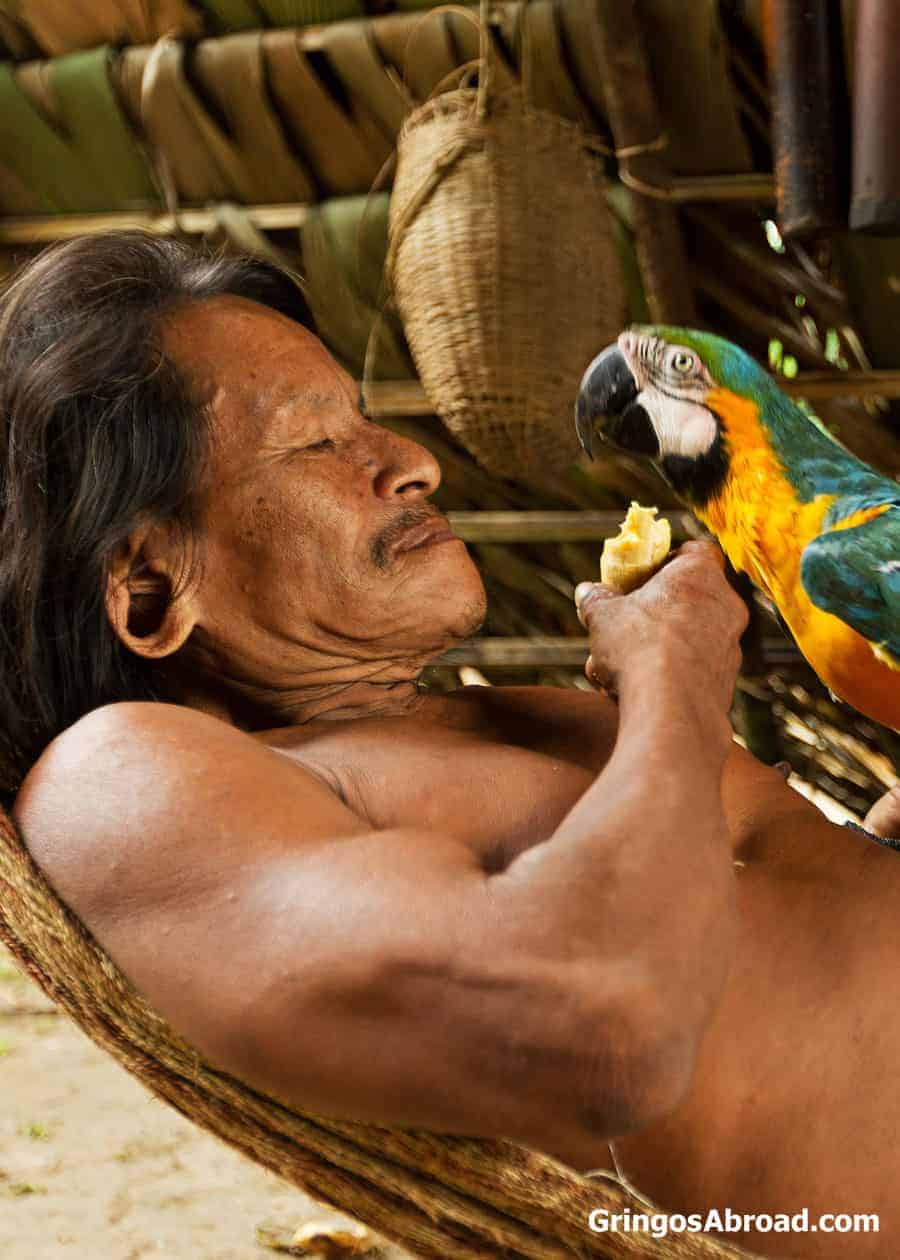
Hungry for even more? Check out our huge guide to the best food in Ecuador.
Kichwa Woman in Rio Blanco, Napo Province, Ecuador
Here’s another example of making traditional chicha.
If you aren’t up for this, you’ll find a recipe for saliva-free, chicha made from yuca, below the video.
Not all chicha is processed with the chew-and-spit method. You can find these saliva-free options in Ecuador. If it matters to you, you should ask first about how it’s made.
Here’s a recipe that you can make at home.
Recipe for Chicha de Yuca (Spit Free Version)
Ingredients
- 2 medium sized yucca
- 1 sweet potato
- water
Preparation
- Peel the yucca and cut into chunks.
- Place the yucca in a large pot, cover with water, and boil until it is soft. Drain but save the water.
- Mash the yucca in a wooden bowl.
- Grate the sweet potato into the saved water.
- Add the mashed yucca to the sweet potato and water.
- Place in a ceramic container to ferment.
- Allow to ferment for at least 24 hours and up to five days.
The above recipe is thanks to notyouraverageamerican.com
Aside from traditional drinks (like chicha) there are many other reasons to visit the Amazon, like these animals.
Your Turn
Have you tried chicha in Ecuador? Will you, if given the chance? Join us in the comments below!



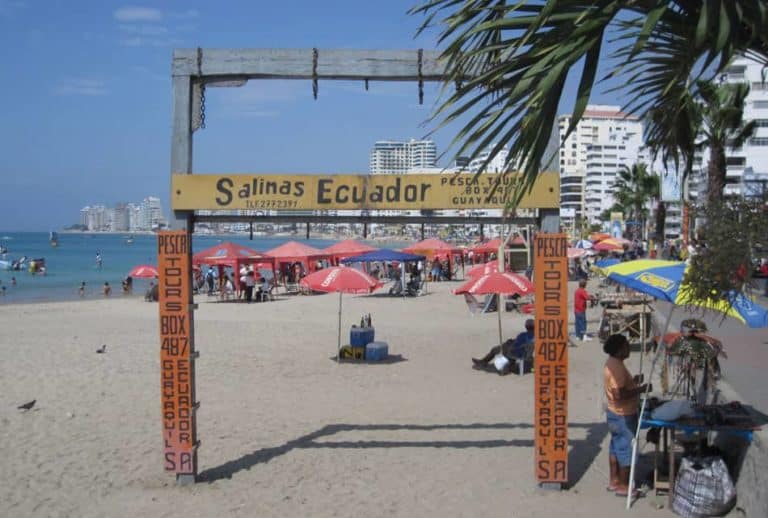
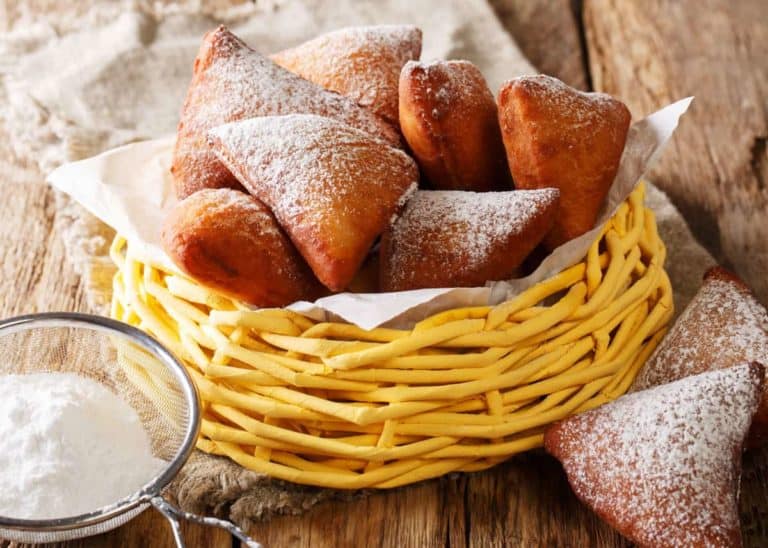

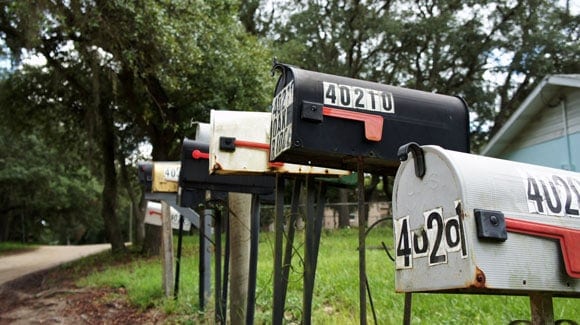
Chicha Morada (purple chicha) should definitely be included here. It is the only Chicha available in refreshment coolers at convenience stores (Snapple makes it). The real Chicha Morada originates in the highland Andes of Peru, made from their purple corn. The Snapple version of Chicha Morada is cloyingly sweet, and so is the Chicha I’ve had in Peru.
My hosts took me from Quito, Ecuador to Guayallabamba, where we ate lunch at a restaurant which I am sure, would prefer to remain nameless. I was asked if I would like to try Chicha. Not wanting to appear to be a NorteAmericano jamtart, I said sure! Within an hour, my digestive system said, unexplained matter detected, am shutting down. All contents to leave by the nearest available exit.
@Robert S (please do not use my last name), that could just be the water, never mind the Chicha. Even the public water in many places will do that. If you eat just one leaf from a salad bar and that leaf was tap-water washed, you can get this problem. Personally, I did just that. Visited a salad bar while meeting my in-laws at the Sheraton in Lima. Took only the clean stuff from the salad bar, except I added one spinach leaf. One danged leaf. That was probably what got me. Ended up in my cousin-in-laws clinic on an IV. That sucked!
Thanks for this well organized article! I was googling to find out if there were various recipes for chicha used in the Ecuadorian Amazon. This article answered ALL my questions and more. The explanation of the name Yuca/Yucca now makes perfect sense to me. Im from East Texas where we have lots of Yucca plants. Ive eaten the flowers and stalks of this plant while foraging and was confused as to how this name could also apply to the Cassava Root. Now I realize I overlooked the extra letter C for years! I will be making a trip to market tonight to get some Cassava Root and sweet potatoes…Its Chicha time!
@Caleb, I hear you about that spelling. I recently bought Yuca on a lark, and only later learned the difference a “C” makes. I had not yet made my Yuca (air-cooked) fries that I intended to because I kept forgetting I needed time to cut and soak it for several hours (per the recipes). Finally yesterday I set it out to make it this week. Just now, for a second time in three weeks, I have come across articles mentioning the spelling – and I was NOT looking for yuca articles nor served them by an algorithm. Surely, this must be a sign then from the universe. I should cook my yuca tomorrow! If I could also drink alcohol, I would try to have alcoholic chicha with it. (I could probably go to Little Peru in Paterson, NJ to get that.)
Only a tiny proportion of chicha in Ecuador is made with yuca – it’s typically made with corn, especially in the highlands. Likewise, only a tiny proportion is made by chewing and spitting. It makes a good headline but the article is misleading
Hey Tom – thanks for your comment. You are correct, there are other ingredients and methods – as the post mentioned. And while the post was written with the traditional Amazonian chicha in mind, that wasn’t spelled out. I’ve adjusted the post to better explain that it is about traditional chicha from the Amazon (as the two embedded videos show). In the Amazon, yuca and verde are more common than corn. And while there are other methods of production, this post was specifically about the tradition process – one that many expats and travelers are interested in.
Thanks!
Just to let you know that with that one article about Ecuador and laws. Me being a Canadian and planning for a healthy climate change year round retirement location. I have changed my direction on addresses. I am looking at Pannama now also being a Canadian bank there and if I still choose to do 6 months in and out or the best plan for my dollar. Everything that you have sent me has been very helpful, the best part is the heads up about the politics,and where I should look to find a quiet place. That I can have property if I choose to
I do not care what other peoples choose to eat or drink. Myself? I don’t think I will try Chicha due to my own gastric system. It is more important to me that people are kind to one other then what they choose to drink (or eat).
I have tried chicha on two different occasions, once in the Napo valley and once near Tema. In both occasions it was offered by tribes sharing some of their culture. As a traveler, I did not want to offend them so I tried. Later it was explained the offering was partially a test to outsiders and if you would drink they would accept you but if not, you would always be and outsider and thus not befriended. I have never tried wall paper paste, but the chicha I tried seemed to have a similar look and consistency, yet I kept those observations to myself when asked.
I had the chance to observe some of their hunting at night as they walked the jungle listening for monkeys that would drop seeds as they ate fruits. The local tribes would stand beneath the monkeys and use their blow guns with the poisonous darts to drop a monkey and then kill. Their techniques reminded me of hunting squirrels as a boy with a pellet rifle. They were selective in the size of monkey they killed, as the small ones were not touched, and the big ones did not taste good. There was a size in the middle that they coveted for it’s taste.
Good hunters learn to move in a stealthy manner, and just like the native north american woodland tribes, my host knew how to glide thru the forest with nary a sound.
I quickly began to respect them for their techniques and ability to travel far in the jungle like a long distance athelete. They also were capable on the water too, canoeing as they navigated the rivers and streams with ease.
One more observation, Casava root called Fufu is ground up in West Africa too, and served in a communal bowl, not fermented but with the consistency of pudding. If you visit a family they will place a big bowl on the table and they use their fingers to dip some out. Yes, I know what you are thinking as everyone uses their hands to dip out of the same bowl.